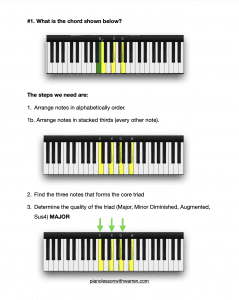Suspension Chords & Chord Inversions
Today’s tutorial covers two aspects of chord theory: suspended chords and chord inversions.
Suspended Chords
Suspended chords are written on chord charts as ‘Csus4’, for example, with ‘sus’ indicating that the C chord is suspended. As you play and listen to the various example progressions given below, you might begin to recognize the sound of suspended chords from their common appearance in contemporary music, such as Christian rock.
It is easy to form suspended chords out of major chords. Take any major chord (e.g., C major, formed of the notes C – E – G), and by raising the 3rd degree of that chord by one-half step, you will create a suspended 4th chord (Csus4, notes: C – F – G). The most standard of the suspended chords is called a suspended 4th, or sus4, as the 4th degree is played in place of the 3rd. In rarer cases, the 4th is played as well as the 3rd. In this case, F, the 4th degree of the C major scale, is played in place of the 3rd E.
This technique of raising the 3rd degree by one half-step can be repeated elsewhere on the piano. For example, taking the chord of G major (G – B – D) and raising the 3rd (B) a half-step to become the 4th (C), we get Gsus4 (G – C – D).
A suspended 4th will generally want to resolve a half-step down to a major or minor chord. To experiment with the movement of suspended chords, try playing them and resolving them to their equivalent major/minor chords, for example, from Csus4 to C major or from Csus4 to C minor. This will give you a good feel for how suspended chords can be used within a song.
In addition to the sus4 chord, we also have what is referred to as a sus2 chord or a suspended 2nd. Sus2 chords can be considered a major chord with the 2nd and/or equivalent 9th degree in place of its 3rd degree. For example, the chord C major is formed of the notes C – E – G. By removing the 3rd (C – G) and replacing it with the 2nd/equivalent 9th (C – D – G), we get a Csus2 chord. Again, in rarer cases, the 2nd or 9th is played as well as the 3rd without replacing it.
You can use the sus2 chord in combination with the sus4. Try playing the following progression for a few revolutions, changing the chord with every bar:
Csus4 (C – F – G) | Csus2 (C – D – G) | Csus4 | C major (C – E – G)
Once you start using suspensions, you can get into some other progressions, such as Csus2 (C – E – G – D) to C major (C – E – G – C), which uses the 9th (D) to resolve to the octave (C). You can also resolve upwards, such as from Csus2 (C – E – G – D) to C major 2nd inversion (G – C – E), where the note D resolves upwards to E.
Suspension chords also work nicely on the scale’s dominant or the 5th chord. For example, try following the next progression, changing chords with every bar:
Csus2 (LH: C – C, RH: C – D – E – G)
Am9 (LH: A – E – G, RH: C – E – G – B)
Dm (LH: D – A, RH: D – F – G)
Gsus4 (LH: G – D – G – C, RH: G – C – D – G) (the 5th chord)
On playing the last chord, Gsus4, you will notice that the piece wants to resolve to G major. Gsus4 can therefore be used as a sort of delay to reach the final chord of a progression, adding a form of suspense to a song before returning to the phrase’s first chord.
I also find that suspension chords work very well when attempting to play a direct modulation. If I am playing in the key of G and want to modulate to the key of D, I can slide an Asus4 between the changing of keys to make the transition sound more natural.
This even works when modulating by a half-step, shown by the following progression, which also demonstrates the use of the sus4 chord:
4/4: G | Em | Am | Csus2 | D | Ebsus4 | Bb | Ab
Suspensions help to make transitions sound smoother and grander while also letting the other musicians you are playing with and the audience know that something big is coming within the piece. Practice using suspensions in different piano keys to grasping their style and how they could be used within music.
Chord Inversions
Each triad can be played in three different ways: in the root position, in the 1st inversion, and in the 2nd inversion.
Using the C major chord as an example, the inversions are as follows:
Root position: C – E – G (most common C major triad)
1st inversion: E – G – C
2nd inversion: G – C – E
The lowest note or pitch within the chord dictates what position or inversion the chord is in. The chord is in its root position when the lowest note in the chord is the root note. In this example, we know that note C is the root of C major, so when we see that C is the lowest note in the chord, the chord is in its root position. Even if your right-hand plays the 1st inversion of E – G – C, but your left-hand plays a bass note of C, you are playing the C major chord in its root position as the lowest pitch in the chord remains as C.
If you play a C major root chord with your right hand but play an E on the bass (written as C/E), then the chord is in 1st inversion, as the inversion is based on which note is the lowest. If G is the lowest note within a C major chord (C/G), then you are playing the 2nd inversion of C major. When a 2nd inversion is used, it usually sets up for a 5-chord, which can be heard when moving between the chords C/G to G major.
Inversions do not change the nature of the chord as a whole. C chords are always composed of the notes C – E – G regardless of what order of pitch they appear in. If we can see those notes C – E – G in the chord, we know it is a C chord.
The chord G/B (B – D – G) is a G chord in 1st inversion. Mostly it is used as a nice walk-down movement, which you can practice using the following progression:
C | G/B | Am | C/G | F | C/E | Dm7 | Gsus4 | G7.
To be able to see your chords in various ways and understand how they chords move, in turn, learning the use of suspended chords and how to incorporate them into smooth, impactful progressions across the keyboard will help you tremendously in whatever music you are playing.
A good way to practice your triads and inversions is to split them into what we call block chords and play them ascending and descending throughout the octaves of the keyboard. Using the C major chord again, these block chords are composed of the notes:
C – E – G – C – E – G (root position)
E – G – C – E – G – C (1st inversion)
G – C – E – G – C – E (2nd inversion)
This can also be practiced with minor inversions..:
C – Eb – G – C – Eb – G
Eb – G – C – Eb – G – C
G – C – Eb – G – C – Eb
..the diminished 7ths..:
C – Eb – F# – A – C – Eb – F# – A
Eb – F# – A – C – Eb – F# – A – C
F# – A – C – Eb – F# – A – C – Eb
..and even with augmented chords:
C – E – Ab – C – E – Ab
E – Ab – C – E – Ab – C
Ab – C – E – Ab – C – E
Practice these chords as block chords, playing all the notes at once, one chord after another, traveling through at least two octaves of the keyboard, and practicing them as broken or arpeggiated chords. It is important to train your left hand in this exercise as much as your right. This is a good exercise in learning how to pick out the three types of chord positions quickly and get them under your finger.
The above exercise will teach you two things: (i) the understanding of various triad inversions and (ii) building good techniques relevant to soloing through the practice of arpeggios and broken chords. By becoming adept at this arpeggiated technique, you start to lay the foundations for improvisatio4 while building dexterity and fluidity within your playing.
Download The 7 Steps To Naming ANY Chord PDF For FREE
With this PDF, you NEVER HAVE TO GUESS what chord you’re playing.


